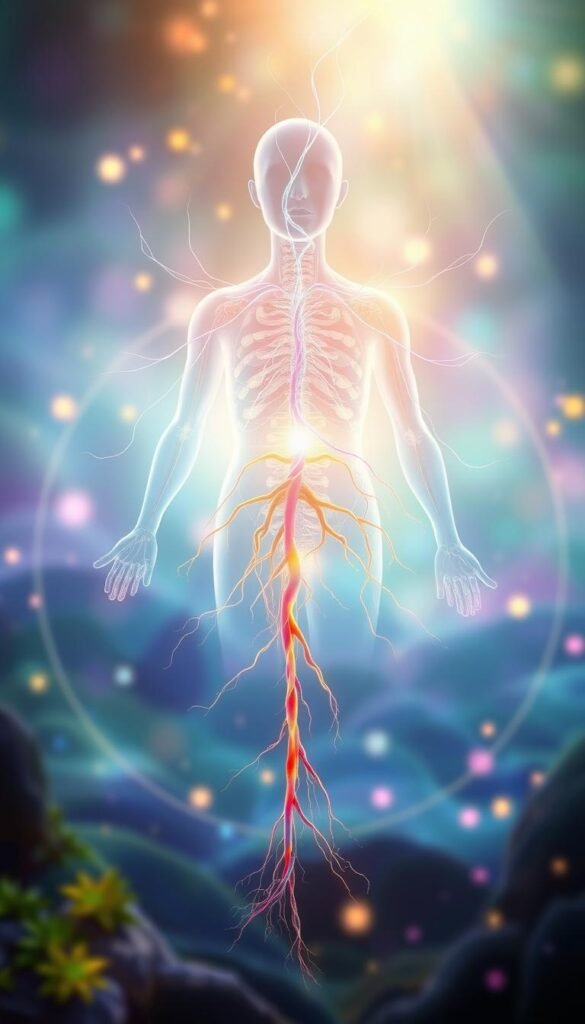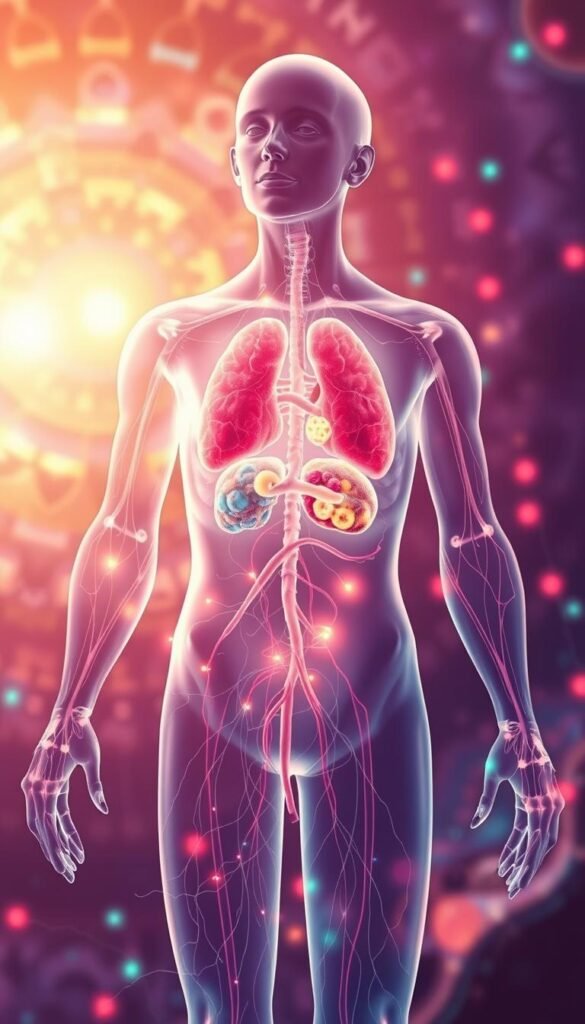Your body is a marvel of nature, constantly working to maintain balance and vitality. At the heart of this process is the lymphatic system, often called the body’s “silent caretaker.” It plays a crucial role in fluid balance and filtering out toxins, ensuring every cell thrives.
Imagine your lymphatic system as a river. When it flows freely, it nourishes every part of your body. But when it’s blocked, it can leave you feeling sluggish. Supporting this vital network is about aligning with nature’s wisdom—gentle movement, mindful nutrition, and self-care practices.
Together, we’ll explore how to honor your body’s innate cleansing rhythm. This journey isn’t just about physical health; it’s about cultivating radiant vitality from within. Let’s begin this path to wellness, one step at a time.
Key Takeaways
- The lymphatic system is essential for fluid balance and toxin removal.
- Natural methods like movement and nutrition support its function.
- Think of it as a river—free flow equals better health.
- Holistic practices can enhance your overall vitality.
- Self-care is key to maintaining this vital network.
Understanding the Lymphatic System
Every cell in your body relies on a hidden network to stay healthy and vibrant. This network, often called the body’s sanitation system, works quietly to remove waste and protect you from harm. Think of it as a water purification plant, filtering out toxins and keeping your internal environment clean.
What is the Lymphatic System?
The lymphatic system is a vast network of lymph nodes, lymph vessels, and secondary organs like the spleen and thymus. It spans your entire body, with clusters of nodes in areas like the neck, armpits, and groin. These nodes act as security checkpoints, trapping harmful substances before they can spread.
Lymph, the fluid that flows through this network, contains proteins, fats, white blood cells, and waste products. It’s returned to the bloodstream via the thoracic duct, ensuring your body stays balanced and healthy.
Key Functions of the Lymphatic System
This system performs four essential roles: maintaining fluid balance, defending against infections, aiding nutrient absorption, and removing waste. It’s like a flowing stream, nourishing your tissues and keeping your immune system strong.
When this network works well, your body feels energized and vibrant. But when it’s blocked, it can lead to issues like swelling or fatigue. Keeping it healthy is key to your overall well-being.
Common Issues with the Lymphatic System
Problems arise when this network becomes congested. Lymphedema, for example, causes swelling in the arms or legs due to excess fluid. Other conditions like lymphoma or lymphadenitis can also disrupt its function.
Think of a healthy system as a flowing stream and a congested one as a swamp. The goal is to keep the channels clear, allowing life force (or prana/chi) to move freely.
| Healthy Circulation | Congested Circulation |
|---|---|
| Free-flowing stream | Swampy stagnation |
| Balanced fluid levels | Excess fluid buildup |
| Strong immune response | Increased risk of infection |
Why Detoxify Your Lymphatic System?

Your inner ecosystem thrives when it’s nurtured and cared for. Think of detoxification as spring cleaning for your body’s hidden pathways. It’s about clearing out the clutter so your vitality can flow freely.
Benefits of Lymphatic System Detox
Supporting your body’s natural cleansing process offers a wealth of benefits. You’ll notice reduced puffiness, clearer skin, and fewer colds. Many people also experience mental clarity and renewed energy.
Here’s what you can expect:
- Less swelling and fluid retention
- Improved immune system function
- Fewer infections and less inflammation
Signs Your Lymphatic System Needs Detoxification
Your body often whispers its needs before they become urgent. Morning stiffness might feel like rusty gate hinges, while brain fog can resemble a veil over your thoughts. Skin issues, like acne or rashes, may signal an overflowing toxin bucket.
Other signs include:
- Persistent swelling or tightness
- Recurring infections or sinus issues
- A heavy sensation in your limbs
Take Sarah’s story, for example. She struggled with chronic sinus infections for years. After a three-month detox plan, her symptoms resolved, and she felt like herself again. Nurturing your body’s pathways before they become congested is key to long-term health.
| Healthy State | Congested State |
|---|---|
| Clear, radiant skin | Acne, rashes, or dullness |
| Strong immune system | Frequent infections |
| Balanced fluid levels | Persistent swelling |
How to Detoxify Your Lymphatic System

Revitalizing your body’s natural pathways can unlock a new level of energy and clarity. Think of it as tending to a garden—when you nourish its hidden streams, you cultivate vibrant health. Here, we’ll explore the Three Pillars of Lymphatic Revival: massage, movement, and mindful nourishment.
Lymphatic Drainage Massage
Gentle touch can awaken dormant streams within your body. A lymphatic drainage massage uses light, rhythmic strokes to encourage circulation and reduce swelling. It’s like clearing debris from a riverbed, allowing the water to flow freely.
This practice is especially helpful after periods of inactivity or stress. It’s a way to reconnect with your body’s natural rhythm and restore balance.
Exercise and Physical Activity
Movement is a joyful way to pump your lymph and boost circulation. Rebounding on a trampoline, for example, uses gravity to enhance flow. It’s like dancing with the moon—light, rhythmic, and uplifting.
Other activities like yoga, walking, or swimming also support your body’s inner streams. The key is to find what feels good and make it a regular part of your routine.
Hydration and Diet
Your tissues thrive when they’re nourished with the right fluids and foods. Herbal infusions, like ginger or dandelion tea, act as liquid light for your cells. They hydrate and gently stimulate your inner pathways.
Your diet plays a crucial role too. Focus on anti-inflammatory foods like cruciferous veggies, wild salmon, and turmeric. Think of your plate as a rainbow, feeding your body’s inner filter system.
| Healthy State | Congested State |
|---|---|
| Free-flowing lymph | Stagnant, sluggish flow |
| Balanced circulation | Swelling and fluid retention |
| Nourished tissues | Dry, irritated tissues |
Remember, small changes can make a big difference. Whether it’s a gentle massage, a brisk walk, or a nourishing meal, each step brings you closer to vibrant health.
Lymphatic Drainage Massage: A Step-by-Step Guide

Imagine guiding lost raindrops back to their river—this is the essence of lymphatic drainage massage. This gentle practice uses light, rhythmic strokes to encourage your body’s natural flow. It’s like clearing debris from a stream, allowing vitality to move freely.
What is Lymphatic Drainage Massage?
This type of massage focuses on stimulating the lymph nodes and vessels. It helps reduce swelling, improve circulation, and support your body’s natural cleansing process. The strokes are feather-light, with a pressure of just 5-20 mmHg, ensuring a soothing yet effective experience.
How to Perform Lymphatic Drainage Massage at Home
You can easily practice this at home with a few simple steps. Begin at your collarbones, using palms softer than rose petals. Follow the moon’s path—upward strokes on your legs and spirals at your joints. Spend about 60 seconds per area, always moving toward the nearest lymph nodes.
Here’s a quick guide:
- Start at the collarbones, the body’s wellspring.
- Use gentle, upward strokes on your arms and legs.
- Apply light spirals at joints like elbows and knees.
When to Seek Professional Help
While home techniques are helpful, some situations require a therapist. For example, after breast cancer surgery, professional sessions can aid healing. Always consult a healthcare provider if you have conditions like blood clots, kidney failure, or active infections.
Here’s when to consider professional care:
| When to Seek Help | Why It’s Important |
|---|---|
| Post-surgery recovery | Supports healing and reduces swelling |
| Chronic swelling | Ensures proper technique and safety |
| Medical conditions | Prevents complications |
Remember, more pressure doesn’t mean better flow. Gentle, intentional touch is the key to unlocking your body’s natural vitality.
Lifestyle Changes for a Healthy Lymphatic System

Small daily habits can create a ripple effect, supporting your body’s natural flow. By integrating simple practices into your routine, you can keep lymphatic system functioning optimally. Think of these changes as daily rituals for lifelong vitality.
Importance of Regular Exercise
Movement is one of the most effective ways to support your body’s inner streams. Activities like yoga, walking, or rebounding on a trampoline encourage lymph vessels to pump fluid efficiently. Even gentle stretches can make a difference.
Try incorporating these practices:
- Yoga sun salutations to greet your lymphatic dawn.
- Foam rolling for fascial release and improved circulation.
- Contrast showers (3 minutes hot, 1 minute cold) to stimulate flow.
Dietary Recommendations
What you eat plays a vital role in maintaining a lymphatic system healthy. Bitter greens like kale and arugula act as nature’s drain cleaners, helping to remove waste. Staying hydrated is equally important—drink plenty water to keep fluids moving.
Here are some dietary tips:
- Include anti-inflammatory foods like turmeric and wild salmon.
- Opt for herbal teas like ginger or dandelion to support detoxification.
- Limit processed foods that can clog your inner pathways.
Reducing Toxin Exposure
Your skin isn’t armor—it absorbs what you put on it. Choose skincare products wisely, opting for natural, non-toxic options. Reducing exposure to environmental toxins is another way to support your immune health.
Consider these steps:
- Dry brushing before showers to stimulate circulation.
- Switch to eco-friendly cleaning products at home.
- Detox during the waning moon phase and build during the waxing phase.
| Healthy Practices | Benefits |
|---|---|
| Regular exercise | Boosts circulation and immune function |
| Mindful diet | Supports lymphatic system healthy |
| Toxin reduction | Reduces burden on your body’s inner streams |
By making these changes, you’re not just caring for your body—you’re nurturing your overall well-being. Start small, and let these habits become your way of life.
Can Hormone Detox Help Improve the Function of My Lymphatic System?
Exploring hormone balance detox strategies could support the function of your lymphatic system. These methods aim to eliminate toxins, thereby enhancing overall health. By promoting optimal hormone levels, the body can better regulate fluid balance and immune response, potentially leading to improved lymphatic flow and overall vitality.
Precautions and When to Avoid Lymphatic Detox
Caring for your body’s natural pathways requires awareness and caution. While supporting your inner streams can be beneficial, certain situations demand a pause. Even rivers need floodgates sometimes to prevent overflow.
Medical Conditions to Consider
Some medical conditions make detox practices unsafe. For example, deep vein thrombosis (DVT) or congestive heart failure can worsen with certain techniques. Infections like cellulitis also require careful handling to avoid spreading.
Here are conditions to be mindful of:
- Deep vein thrombosis (DVT): Avoid massages that could dislodge clots.
- Congestive heart failure: Excess fluid movement may strain the heart.
- Active infections: Techniques could spread bacteria or viruses.
Consulting Your Healthcare Provider
Before starting any new regimen, consult your healthcare provider. They can assess your unique needs and ensure safety. For instance, James postponed his detox plan until after cardiac clearance, ensuring his heart was stable.
Look out for red flags like crimson streaks or pulsing pain. These symptoms may signal underlying issues needing immediate attention. Collaboration between your healthcare provider and massage therapist is key to safe and effective care.
| Absolute Contraindications | Relative Contraindications |
|---|---|
| Deep vein thrombosis (DVT) | Pregnancy |
| Congestive heart failure | Diabetes |
| Cellulitis | Hypertension |
Medications like blood thinners also require caution. Always discuss your treatment plan with your healthcare provider to avoid complications. Your body’s well-being is a shared journey, guided by wisdom and care.
Conclusion
Embracing your body’s natural rhythm is like stepping into a flowing river of vitality. Just as spring follows winter’s stagnation, your inner streams awaken with gentle care. These sacred steps toward fluid grace are simple yet profound.
Begin with one daily ritual that supports your wellbeing. Whether it’s a mindful walk, a nourishing meal, or a moment of stillness, each act nurtures your inner flow. Remember, you’re not just a body—you’re a flowing universe, connected to the rhythms of life.
As the river needs flow, so your inner streams need glow. Consult your healthcare provider if needed, and trust the wisdom of your health. Start today, and let your vitality shine.
